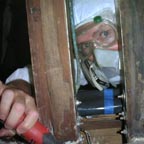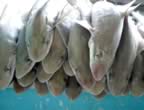|
Log - 9/13 - 12/1/2003 Trinidad to Grenada In this log Alan describes refitting the boat in Trinidad and sailing north to Grenada and Carriacou. This page includes the following sections:
Return to Trinidad (Sept 13, 2003 10°41´N, 61°38´W) It took seven minutes to check in at the America West ticket counter. But now we know why you are supposed to be at the airport two hours before our departure time – it provides ample time to track down George (Katherine’s dad) and have him return to the house and pick up the Katherine forgotten carryon bag and deliver it to us at the airport. The overnight flight to New York was fine, but things started deteriorating with the final leg on BWIA (British West Indies Airlines). The packed BWIA jet left New York an hour late, took the scenic route around hurricane Isabel, added an extra stop in Antigua, and lost one of my bags somewhere along the way. This put us in Port-of-Spain during rush hour traffic, and the marine customs office after hours. Luckily the customs office is happy to accept a reasonable overtime fee and fulfill our cravings for bureaucratic hogwash after 5 p.m. Four hours later than expected, we arrived at the boatyard tired, hungry, and bitchy. Trying Times in Trinidad (Sept 14, 2003 10°41´N, 61°38´W) The next day we became reacquainted with my sailboat. It was hot,
dirty, a little moldy, and a little buggy. But after renting an
air conditioner, washing the beast, and two days of menial toil
the boat started to become habitable – except for the cockroaches
– these tenacious demons weighed heavy on Katherine’s
soul. Then, Gabriel (of s/v Tango) solved our crisis — with
a single application of a product called "Goliath". Application
only required about five minutes to distribute a drop of Goliath
in each of about twenty nooks and crannies. Two weeks later, the
boat was cockroach free; this French product is truly a miracle!
After launching, s/v Squiz moved to a marina and the work continued for five weeks. In addition to a hundred little maintenance chores we:
In short, a great deal of worthwhile and well-done boat work was
accomplished. (Although I am disappointed in the quality of the
canvas work done by the Trinidadians.) One evening we visited a predominately Hindu town, to get a taste of the Diwali celebration. Diwali is a Hindu festival (held in late October and November) celebrating Lakshmi, goddess of light and wealth, as well as the Hindu New Year. The festival, whose name means "garland of lamps," is marked by the lighting of lamps and candles (inviting the goddess into the house), feasting, and the exchange of gifts. Diner consisted of a variety of yummy, unidentifiable, vegetarian mounds served on a big leaf and eaten with your fingers. Then we wandered around town looking at the lights. The local women were often dressed in splendid saris (smile); the local men usually wore T-shirts (yawn). It was a real nice escape — until the traffic jam of vehicles trying to get in and out of town bogged down our uncomfortable taxi-van (and we averaged 2 MPH trying for 1.5 hours). Ah, the unexpected joys of cultural diversity. Monday, November 10th, we finally completed the host of exhausting boat projects and escaped Chaguaramas. For her maiden voyage, s/v Squiz motored five miles west to Scotland Bay (still in Trinidad). Surrounded by forest and inaccessible by road, Scotland Bay is world away from the sounds, sweat, and expense of the Chaguaramas boatyards and marinas. We rested peacefully at anchor, with sonic color supplied by twittering birds and buzzing insects and macabre howler monkeys. North to Grenada (Nov 20, 2003 - 12°01´N, 61°41´W) We waited two days waiting in Scotland Bay for a nice weather forecast — a 10 knot breeze out of the ESE. I planned for a late afternoon departure for the 80 nautical mile crossing to Grenada, so we could arrive in during morning daylight hours. Leaving Trinidad, Squiz was accompanied by a couple rain squalls and choppy seas. Luckily, conditions soon mellowed out. 7-15 knot ENE winds and four foot waves made for an easy passage to St David's, on the south shore of Grenada. I located the door open to the unlabelled customs and immigration office. Entering at 12:30, I found the customs officer asleep with his feet propped up on his desk. I quietly retreated and knocked on the open door. He eventually awoke and as me to return in after 1 PM. After checking into customs and immigration and rested for the night, we moved a few miles over to a nearby bay where we had the anchorage all to ourselves (a rarity in the busy Caribbean)! We probably were blessed by this peaceful, solitary anchorage because the popular cruising guide states "the entrance by yacht is tricky and should only be attempted by experienced reef navigators". (I think the entrance was straightforward if you keep a good eye out for reefs). It is great to be cruising and swimming again; although the underwater life and visibility is disappointing so far. Continuing along the south coast of Grenada, we visited the popular Hog Island and Mt. Hartman anchorages. Then, on a squally day, with variable winds and rains, we motor-sailed up to the small island of Carriacou — located in the southern Grenadines. The long-term forecast was unfavorable for our next big passage north to Martinique; so we anchored in well-protected Tyrrel bay and prepared to stay a while. Marauding Cats of Carriacou (Nov 27, 2003 - 12°27´N, 61°29´W) The blustery, rainy weather continued. On Thanksgiving afternoon an announcement on the VHF radio indicated two catamarans in Tyrrel Bay were dragging their anchors. Peering through the driving rain we saw a large Catana catamaran 100 yards upwind of us dragging quickly down toward us. I hopped in the dinghy and pushed the unmanned marauder sideways as Katherine deployed some fenders and prepared to take evasive action. With the help of another cruiser in a dinghy, we were able to force the dragging catamaran to the side until it bumped past Squiz (with no damage). Then I climbed aboard the catamaran, let out more anchor chain, and deployed their second anchor. Meanwhile, the second unmanned dragging catamaran was bearing down on two other monohulls. Using similar tactics we fended off the second unoccupied beast, until the monohulls safely weighed anchor and moved out of the evil catamaran's path. |
Other Related Pages: Adam and Eve had many advantages, but the principal one was that they escaped teething.
If one only wished to be happy, this could be easily accomplished; but we wish to be happier than other people, and this is always difficult, for we believe others to be happier than they are. |
|

